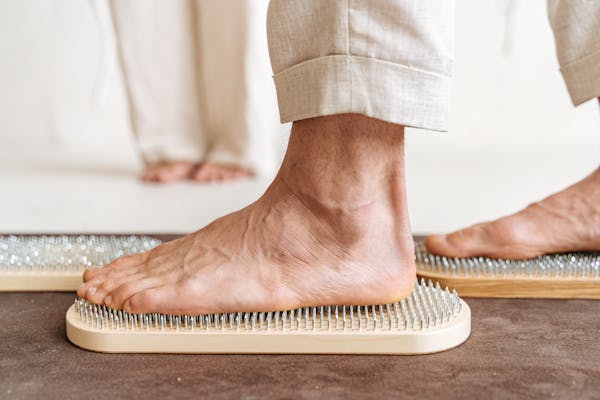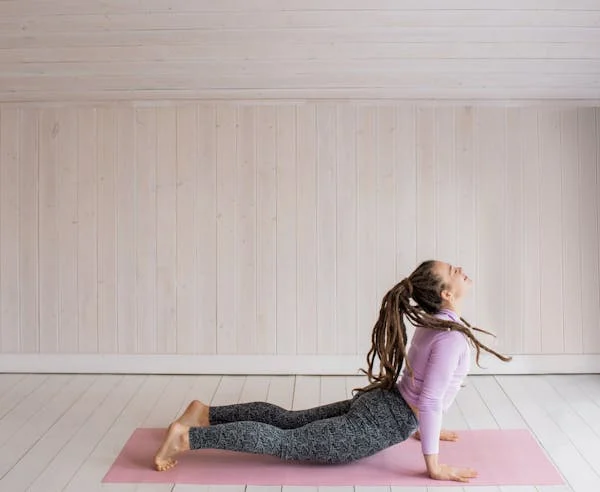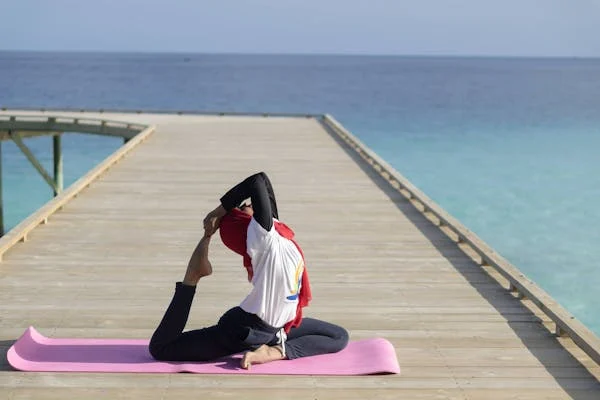Table of Contents
1. Introduction Understanding the Importance of Blood Pressure Management
Yoga for Blood Pressure Reduction – Blood pressure is one of the most important vital signs of overall health, as it reflects the force of blood pushing against the walls of arteries as the heart pumps it through the body.
If blood pressure is too high (hypertension), it can lead to severe complications such as heart disease, stroke, kidney damage, and other health problems. Blood pressure fluctuates naturally throughout the day, but if it remains consistently high, it can be dangerous.
Such management programs for this ailment have given rise to blood pressure-reduction techniques through yoga, which allows more holistic means without the usual accompanying side effects like pharmaceutical medications often do.
One can help regain balance on his or her part by performing specified yoga postures, breathing exercise, and mediation, among many others. As a result of these habits adopted in everyday lives, one will feel the changes reflected in lowerings the blood pressure rates.
Many people have to deal with stress in their daily lives, which may raise blood pressure even further. Yoga provides a potent means of countering this by being a practice of relaxation, mindfulness, and enhanced blood flow.
This is the reason why so many people who want to move away from allopathic medication are interested in natural blood pressure control.

2. What is Blood Pressure and Why Does It Matter?
Blood pressure is the force of blood against the walls of your arteries due to the pumping of the heart. Blood pressure measurements are usually indicated by two numbers: systolic and diastolic.
The systolic number, the top number, indicates the pressure at which the heart beats and pumps blood. The diastolic number, the bottom number, indicates the pressure when the heart is resting between beats.
The normal range for blood pressure is usually 120/80 mmHg. A reading of more than 130/80 mmHg is classified as high blood pressure or hypertension and can be a significant risk factor for heart disease and stroke.
If left untreated, hypertension may lead to chronic health issues like heart failure, kidney disease, and even blindness.
The causes of high blood pressure include poor diet, inadequate exercise, excessive salt intake, obesity, and stress.
Genetics and family history are also significant contributors, but even among those who have these factors, lifestyle changes contribute significantly to blood pressure management.
Yoga can therefore help overcome most of these risk factors, as well as reduce tension, improve the circulatory systems, and establish healthier lifestyles.
While regular practice was reported to dramatically decrease both the systolic and diastolic pressures, thereby using yoga as an adjunct to medical treatment to alleviate hypertension,


3. Yoga’s Impact on Blood Pressure
For many centuries, yoga is considered to develop the flexibility of limbs, strengthening, and mental acuteness. Its impact reaches even into the heart and circulatory system.
This is because one of the primary mechanisms by which yoga can help decrease blood pressure is by stimulating the parasympathetic nervous system, the “rest and digest” component of the autonomic nervous system. It functions on opposite lines of the sympathetic nervous system that is responsible for the “fight or flight” response, thus increasing heart rate and blood pressure in stressful conditions.
Through deep breathing and relaxation, yoga for blood pressure reduction can lower heart rate and promote relaxation. Regular practice of yoga improves blood circulation, reduces arterial stiffness, and lowers the body’s overall stress levels, which results in more efficient blood flow and a healthier heart.
Certain yoga poses also target blood circulation directly. Inversions, for instance, help blood flow from the lower part of the body back toward the heart in poses such as Legs Up the Wall Pose, or Viparita Karani. This helps decrease the burden on the heart and regulates blood pressure.
Pranayama is another essential practice in yoga that causes a fall in blood pressure: the breathing exercises. The deep belly breathing and slow, controlled exhales stimulate the vagus nerve, which results in a calming effect on the body, reducing stress and, accordingly, lowering blood pressure over time.
4. Top Yoga Poses for Lowering Blood Pressure
There are several yoga poses that can specifically help reduce blood pressure and support heart health. Below are the top yoga poses for blood pressure reduction:
Mountain Pose (Tadasana): This is a foundational standing posture that encourages proper posture, alignment, and breathing. It creates awareness of body positioning and a sense of groundedness. When done mindfully, the pose can reduce stress and anxiety; in turn, this may lower blood pressure.
Child’s Pose (Balasana): This is a restorative pose that calms the whole body. It helps in letting go of all the tension within the back, neck, and shoulders and aids in deep breathing.
Child’s Pose is one of the best ways to soothe the nervous system and, therefore, help alleviate hypertension brought about by stress.
Cat-Cow Pose (Marjaryasana-Bitilasana): This fluid sequence alternates between arching and rounding of the back, stimulating the spine and improving blood circulation. Rhythmic motion in Cat-Cow can even soothe the mind and stress, making it helpful for lowering blood pressure.
In Legs Up the Wall Pose, the legs are positioned in Viparita Karani, an inversion that encourages the return of venous blood flow from the legs to the heart. The pose often reduces tension in the legs, reduces swelling, and promotes overall circulation, as it increases return to the heart and consequently helps regulate blood pressure.
Setu Bandhasana: This pose, popularly known as Bridge Pose, opens the chest, gives stimulation to the heart, and strengthens the glutes, the lower back, and the legs. It increases blood flow to the heart and thus regulates blood pressure while offering a gentle stretch to the body.
Corpse Pose (Savasana): Savasana is an ending relaxation asana in several yoga practices. It provides rest to the entire body and teaches deep, attentive breathing. This pose leads the practitioner into the parasympathetic mode, slowing the heart rate and lowering blood pressure.


5. Breathing in Yoga for the Reduction of Blood Pressure
Adding pranayama (breathing exercises) to your yoga practice can really have an impact on blood pressure. Through controlled, deep breathing, you stimulate the parasympathetic nervous system, which in turn reduces heart rate and blood pressure. Here are three good breathing techniques to help lower blood pressure:
This one is Alternate Nostril Breathing or Nadi Shodhana, through which a breathing process alternates from nostril to another using your fingers on both the nostrils.
This facilitates relaxation and equilibrium in an individual and can further help alleviate anxious conditions, blood pressure. Improving energy circulation within the body, Nadi Shodhana also helps relax the nervous system as well as boosts circulation.
Ujjayi Breath (Victorious Breath): This breath is created by partially constricting the throat to produce a soft, ocean-like sound while breathing in and out through the nose. Ujjayi breath helps regulate blood flow, promotes calmness, and reduces the effects of stress on the body.
Brahmari (Bee Breath): This is the technique of producing a humming sound while exhaling. It is soothing to the nervous system and has an anxiety-reducing effect, which is one of the major causes of high blood pressure. Brahmari is most effective in the head and neck regions, where stress usually collects.
6. Role of Meditation in Blood Pressure Control
Meditation is another tool used to manage blood pressure. Practiced in tandem with yoga, meditation helps reinforce the positive impacts of the exercise by encouraging the individual to be mindful and relaxed.
Mindfulness meditation is one type of meditation that helps reduce blood pressure by teaching an individual to observe their thoughts and emotions and minimize the reaction and stress involved in such behavior.
One finds that meditation improves calmness, emotional balance, and a lowered level of cortisol, the hormone that causes increased blood pressure in many cases.
In addition to these benefits, regular meditation contributes to better concentration and emotional management, which increase feelings of wellness and reduce high blood pressure.
7. The Contribution of Long-Term Regular Yoga Practice Toward Blood Pressure Control
Yoga for blood pressure lowering is definitely not an activity related to periodical practice, but rather the development of a regular practice that will promote long-term cardiovascular well-being.
Repeated yoga practice fortifies the heart, improves circulation, and lessens the effects of stress. With time, this results in sustained lowering of blood pressure.
For patients with hypertension, yoga may be an integral part of treating and preventing the disease. You can definitely reduce the risk of heart disease, stroke, and many other complications from hypertension by practicing yoga regularly.
It also fosters healthy lifestyle behaviors that promote blood pressure management through quality sleep, lower stress, and ideal body weight.


8. Yoga for Blood Pressure Reduction: Getting Started
Getting into the yoga practice can be intimidating; however, anyone can make yoga a part of their life if done correctly. Start with basic, easy postures and build up gradually to the complex one. Instead of focusing on your breathing, constantly stay in the moment with an effort not to strain or cause any discomfort.
If you have high blood pressure, you should consult a healthcare provider before starting a new exercise routine. They may give you specific recommendations or adjustments to your practice.
9. Yoga and Healthy Lifestyle: Combining Practices for Better Results
Yoga should be a part of a healthy lifestyle for the management of blood pressure. Along with yoga, one should maintain a healthy diet, exercise regularly, and get enough sleep. In this way, by incorporating yoga into your daily routine along with other healthy habits, you can improve your overall health and well-being.
10. Conclusion: Take to Yoga for a Healthier Heart
In conclusion, yoga for blood pressure reduction is a natural and effective way to manage hypertension and improve overall cardiovascular health.
It focuses on relaxation, mindfulness, and breath control, which can help lower blood pressure, reduce stress, and promote better circulation. By practicing yoga regularly, you can take charge of your heart health and experience the long-term benefits of a calmer, more balanced life.
